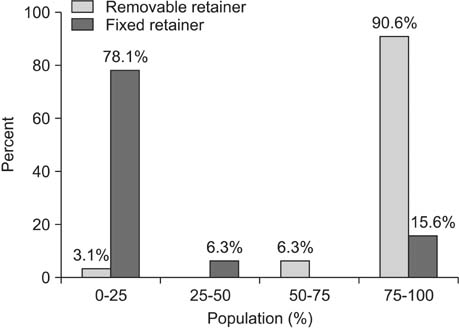Korean J Orthod.
2016 Jan;46(1):36-41. 10.4041/kjod.2016.46.1.36.
A survey on retention practice among orthodontists in Malaysia
- Affiliations
-
- 1Orthodontic Unit, School of Dental Sciences, Universiti Sains Malaysia, Malaysia. normaabrahman@gmail.com
- KMID: 2152896
- DOI: http://doi.org/10.4041/kjod.2016.46.1.36
Abstract
OBJECTIVE
The aim of this study was to evaluate retention practices commonly employed by orthodontists. The objectives were to identify the types of retainer frequently used and to investigate the variations in retention practice.
METHODS
A total of 97 orthodontists were randomly selected, and a questionnaire consisting of 25 multiple-choice questions sent to them by mail. Upon receiving of the completed questionnaires, the data were statistically analyzed.
RESULTS
A total of 32 responses were received; among these, 59.4% of orthodontists' practiced is in a government setting and 40.6% were in private practice. A vacuum-formed retainer was the most commonly used removable retainer for both maxillary (46.9%) and mandibular (46.9%) arches, followed by a Hawley retainer (maxilla, 43.8%; mandible, 37.5%), and a fixed retainer (maxilla, 3.1%; mandible, 9.4%). Of the responding orthodontists, 78.1% prescribed full-time wear (more than 20 h per day) for a duration of 3-9 months for a maxillary arch, compared to 71.9% for the mandibular arch. Only 18.8% of the orthodontists prescribed part-time wear of the retainer for the maxillary arch, compared to 21.9% for the mandibular arch. The majority of orthodontists did not instruct their patients to stop wearing removable retainers (71.9%) or fixed retainers (66.8%) at any specific time and they preferred their patients to continue wearing retainers.
CONCLUSIONS
Vacuum-formed retainers are the most commonly used retainers among orthodontists. The majority of orthodontists prescribed full-time wear for more than 20 h per day with a duration of 3-9 months and preferred indefinite use of the retainer.
Figure
Cited by 2 articles
-
Mandibular arch orthodontic treatment stability using passive self-ligating and conventional systems in adults: A randomized controlled trial
Norma Ab Rahman, Mang Chek Wey, Siti Adibah Othman
Korean J Orthod. 2017;47(1):11-20. doi: 10.4041/kjod.2017.47.1.11.Reader's Forum
Jung-Sub An
Korean J Orthod. 2017;47(3):149-150. doi: 10.4041/kjod.2017.47.3.149.
Reference
-
1. Johnston C, Burden D, Morris D. Clinical guidelines: Orthodontic retention. London: Royal College of Surgeons;2008. Revised November 2008.2. Renkema AM, Sips ET, Bronkhorst E, Kuijpers-Jagtman AM. A survey on orthodontic retention procedures in The Netherlands. Eur J Orthod. 2009; 31:432–437.
Article3. Littlewood SJ, Millett DT, Doubleday B, Bearn DR, Worthington HV. Retention procedures for stabilising tooth position after treatment with orthodontic braces. Cochrane Database Syst Rev. 2006; (1):CD002283.
Article4. Keim RG, Gottlieb EL, Nelson AH, Vogels DS 3rd. 2002 JCO study of orthodontic diagnosis and treatment procedures. Part 1. Results and trends. J Clin Orthod. 2002; 36:553–568.5. Wong PM, Freer TJ. A comprehensive survey of retention procedures in Australia and New Zealand. Aust Orthod J. 2004; 20:99–106.6. Pratt MC, Kluemper GT, Hartsfield JK Jr, Fardo D, Nash DA. Evaluation of retention protocols among members of the American Association of Orthodontists in the United States. Am J Orthod Dentofacial Orthop. 2011; 140:520–526.
Article7. Valiathan M, Hughes E. Results of a survey-based study to identify common retention practices in the United States. Am J Orthod Dentofacial Orthop. 2010; 137:170–177.
Article8. Kish L. Survey sampling. New York: John Wiley and Sons;1965. p. 45–52.9. Singh P, Grammati S, Kirschen R. Orthodontic retention patterns in the United Kingdom. J Orthod. 2009; 36:115–121.
Article10. Meade MJ, Millett D. Retention protocols and use of vacuum-formed retainers among specialist orthodontists. J Orthod. 2013; 40:318–325.
Article11. Vandevska-Radunovic V, Espeland L, Stenvik A. Retention: type, duration and need for common guidelines. A survey of Norwegian orthodontists. Orthodontics (Chic.). 2013; 14:e110–e117.
Article12. Lai CS, Grossen JM, Renkema AM, Bronkhorst E, Fudalej PS, Katsaros C. Orthodontic retention procedures in Switzerland. Swiss Dent J. 2014; 124:655–661.13. Arnold SN, Pandis N, Patcas R. Factors influencing fixed retention practices in German-speaking Switzerland: A survey. J Orofac Orthop. 2014; 75:446–458.
Article14. Reitan K. Clinical and histologic observations on tooth movement during and after orthodontic treatment. Am J Orthod. 1967; 53:721–745.
Article15. Edwards JG. A study of the periodontium during orthodontic rotation of teeth. Am J Orthod. 1968; 54:441–461.
Article
- Full Text Links
- Actions
-
Cited
- CITED
-
- Close
- Share
- Similar articles
-
- Mediating effect of practice environment of nursing work between emotional labour and intention of retention in nurses
- Erratum: Factors associated with anemia among female adult vegetarians in Malaysia
- A Paradoxical Phenomenon: Hemichorea-Hemiballismus Resolution After Stroke in Moyamoya Disease
- The Growing Problem of Radiologist Shortage: Malaysia’s Perspective
- “Free Hand†or Wire Guide: To the Editor




